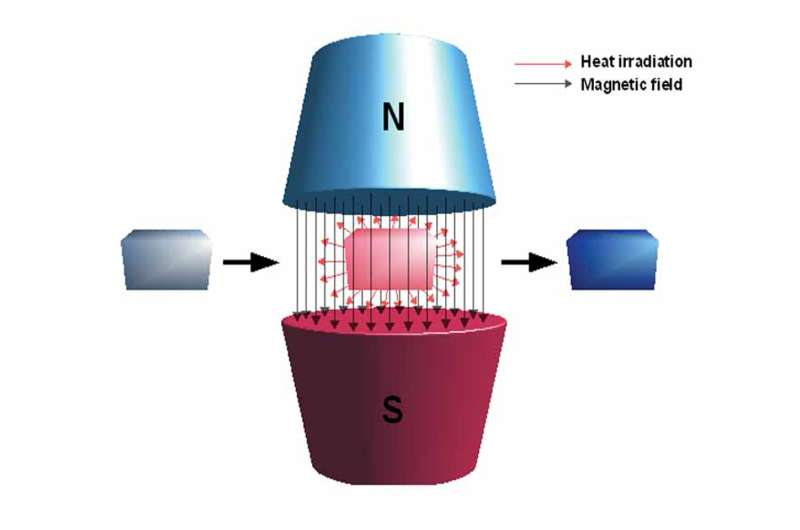Physicists discover new peculiarities of a material with a giant magnetocaloric effect

Scientists from the Lomonosov Moscow State University, together with their colleagues from the United Kingdom and Japan, showed that the smallest structural change in iron-rhodium alloys may result in a significant change in its magnetocaloric properties. The work will be presented at the Seventh International Conference on Magnetic Refrigeration at Room Temperature in Turin from September 11-14, 2016.
The magnetocaloric effect (MCE) is manifested in cooling or heating of the magnetic material (a material having magnetic properties) in an external magnetic field. This phenomenon was first discovered in the 19th century, but the first theoretical justification was obtained some 40 years later. In recent decades, MCE has been thoroughly studied. The measurement of the MCE is used as a method of study of the magnetic phase transitions in different materials—the MCE data is used to refine the phase diagrams of magnetic materials. Secondly, the MCE has many possible applications. Magnetocaloric materials have been successfully used to produce ultra-low temperatures, and also have good prospects in the production of heat engines and refrigeration units.
In the course of the study, the scientists found that the slightest dislocation in the crystal structure of FeRh alloys has a significant impact on the manifestation of MCE. According to one of the authors, Radel Gimaev, the findings will help to improve the applied uses of the MCE.
The researchers focused on an alloy of iron and rhodium to study the MCE. As Radel Gimaev explained, this alloy was chosen for several reasons. The most interesting is that this material has the highest values of MCE of all known to date. "In the scientific literature, there are mentions of changing the temperature to 13K in magnetic fields up to two Tesla. On our sample with the same fields, we received 7.5K," said Radel Gimaev.
As in all magnets, the maximum value of the MCEis achieved under temperatures close to the phase transition temperature. In this case, the transition is from antiferromagnetic state with relatively weak magnetic properties into a ferromagnetic state. In such alloys, the phase transition occurs at temperatures close to room temperature or human body temperature, which is very important for prospective applications. "In addition, the phase transition temperature of these alloys can be set with high accuracy by palladium or platinum doping," says the scientist.
Unfortunately, this alloy is not relevant for magnetic refrigeration due to the high cost of rhodium. It should be noted that today, the main obstacle to the commercialization of magnetic refrigerators is the high cost of the working element and the magnetic field sources. The scientists are seeking new, relatively cheap materials with high magnetocaloric properties.
The perfect crystal structure for obtaining the maximum value of the MCE in iron-rhodium alloys is considered to be a body-centered cubic lattice (bcc), the unit cell of which is a set of iron atoms arranged at the vertices of a cube and rhodium atoms at its center. It is worth adding that such a structure in the iron-rhodium alloys is formed only in the case of an equiatomic composition, i.e., composition with approximately equal amounts of iron and rhodium atoms.
To ensure such a bcc-structure, the samples were subjected to a 48-hour oven annealing at 1000 degrees Celsius. However, the bcc structure of the alloys contained defects, namely the substitution about 2 percent of iron atoms with rhodium and vice versa. As a result, the researchers showed that even such slight deviations from the ideal bcc structure significantly alter the display of the magnetocaloric effect: The sample temperature changes approximately two times less and the phase transition temperature shifts. Moreover, the "irreversibility" effect was discovered when the final temperature of the alloy is not equal to the initial one after a complete cycle of the external magnetic field changes.
According to Gimaev, the work will help to increase the effectiveness of the applied use of the magnetocaloric effect. Secondly, he said, these studies reveal the previously unknown features of the phase transition of the first order in the studied alloys series and thereby deepen the understanding of the causes of the giant MCE.
More information: V. I. Zverev et al. Influence of structural defects on the magnetocaloric effect in the vicinity of the first order magnetic transition in Fe50.4Rh49.6, Applied Physics Letters (2016). DOI: 10.1063/1.4949355
Journal information: Applied Physics Letters
Provided by Lomonosov Moscow State University



















